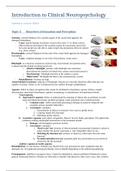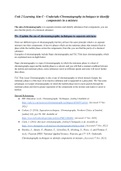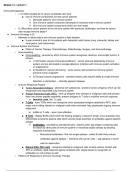Chromatography
Chromatography - used to separate
biomolecules from other molecules in
complex mixtures
A convenient way to detect proteins is by measuring absorbance of UV light.
Proteins generally show absorption maxima around 280 nanometres.
Absorbance of UV light at the wavelength of 280 nanometres by proteins is
primarily caused by the presence of tryptophan and, to a lesser degree, tyrosine.
This method has limited sensitivity and does not deter other amino acids.
A very high-sensitivity detection reagent of amines such as amino acids is the
OPA reagent, o-phthalaldehyde, which reacts with amino groups of amino acids
to form isoindole derivatives. These isoindole derivatives are fluorophores. They
absorb light at a specific wavelength and emit light of a longer wavelength. So,
OPA derivatised amino acids can be detected by fluorometry, using an excitation
wavelength of 348 nanometres and by detecting emission at 450 nanometres.
In the separation and analysis of biomolecules, biochemistry makes generally
use of a liquid mobile phase and a solid stationary phase.
The separation of substances occurs due to different chemical properties,
specifically the interaction with the mobile and stationary phases. A molecule
might not interact with the stationary phase at all and will move unhindered with
the mobile phase. The other extreme would be if a substance would not interact
with the mobile phase and interact with the stationary phase.
In this case, it would bind to the stationary phase and not move with the mobile
phase at all. All other substances would behave somewhere in between and
would be separated based on their differential retention by the stationary phase,
in other words, by the differential partitioning between mobile and stationary
phases.
Ion-exchange chromatography
Ion exchange chromatography separates substances based on charge.
Chromatography 1
, Ion exchange resins are either cation exchange resins which bind positively
charged ions, cations, or anion exchange resins which bind negatively charged
ions, anions.
The chemical functions on ion exchange resins that provide charge are acidic or
basic functions.
Here, we are discriminating strongly acidic groups that are fully dissociated,
regardless of pH, such as the sufonic acid group, and strongly basic groups
which are fully protonated, regardless of pH, such as the quaternary ammonium
group, from weak acidic or basic groups whose degree of protonation is
dependent on their pKas.
Let’s discuss as example ion exchange chromatography using a strong cation
exchange resin.
The buffer which provides the mobile phase generally contains a salt such as
sodium chloride or potassium chloride at low concentrations.
In case of cation exchange chromatography, the positively charged sodium
cation would interact with the cation exchange resin as well as any positively
charged molecule such as the amino acid lysine at pH 7.
At low salt concentrations, and therefore low concentrations of sodium ions,
lysine would be able to bind to the cation exchange resin via electrostatic
interactions between its positively charged side chain and the negatively
charged cation exchange resin.
Note that binding of lysine displaces the sodium cation. In other words, it
competes with the sodium ions for binding to the cation exchange resin. For this
Chromatography 2
Chromatography - used to separate
biomolecules from other molecules in
complex mixtures
A convenient way to detect proteins is by measuring absorbance of UV light.
Proteins generally show absorption maxima around 280 nanometres.
Absorbance of UV light at the wavelength of 280 nanometres by proteins is
primarily caused by the presence of tryptophan and, to a lesser degree, tyrosine.
This method has limited sensitivity and does not deter other amino acids.
A very high-sensitivity detection reagent of amines such as amino acids is the
OPA reagent, o-phthalaldehyde, which reacts with amino groups of amino acids
to form isoindole derivatives. These isoindole derivatives are fluorophores. They
absorb light at a specific wavelength and emit light of a longer wavelength. So,
OPA derivatised amino acids can be detected by fluorometry, using an excitation
wavelength of 348 nanometres and by detecting emission at 450 nanometres.
In the separation and analysis of biomolecules, biochemistry makes generally
use of a liquid mobile phase and a solid stationary phase.
The separation of substances occurs due to different chemical properties,
specifically the interaction with the mobile and stationary phases. A molecule
might not interact with the stationary phase at all and will move unhindered with
the mobile phase. The other extreme would be if a substance would not interact
with the mobile phase and interact with the stationary phase.
In this case, it would bind to the stationary phase and not move with the mobile
phase at all. All other substances would behave somewhere in between and
would be separated based on their differential retention by the stationary phase,
in other words, by the differential partitioning between mobile and stationary
phases.
Ion-exchange chromatography
Ion exchange chromatography separates substances based on charge.
Chromatography 1
, Ion exchange resins are either cation exchange resins which bind positively
charged ions, cations, or anion exchange resins which bind negatively charged
ions, anions.
The chemical functions on ion exchange resins that provide charge are acidic or
basic functions.
Here, we are discriminating strongly acidic groups that are fully dissociated,
regardless of pH, such as the sufonic acid group, and strongly basic groups
which are fully protonated, regardless of pH, such as the quaternary ammonium
group, from weak acidic or basic groups whose degree of protonation is
dependent on their pKas.
Let’s discuss as example ion exchange chromatography using a strong cation
exchange resin.
The buffer which provides the mobile phase generally contains a salt such as
sodium chloride or potassium chloride at low concentrations.
In case of cation exchange chromatography, the positively charged sodium
cation would interact with the cation exchange resin as well as any positively
charged molecule such as the amino acid lysine at pH 7.
At low salt concentrations, and therefore low concentrations of sodium ions,
lysine would be able to bind to the cation exchange resin via electrostatic
interactions between its positively charged side chain and the negatively
charged cation exchange resin.
Note that binding of lysine displaces the sodium cation. In other words, it
competes with the sodium ions for binding to the cation exchange resin. For this
Chromatography 2










